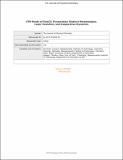STM Study of Gold(I) Pyrazolates: Distinct Morphologies, Layer Evolution, and Cooperative Dynamics
Author(s)
den Boer, Duncan; Krikorian, Markrete; Esser, Birgit; Swager, Timothy Manning
Downloads1-ln1330260-1799488372-1939656818Hwf-970153045IdV21110955281330260PDF_HI0001.pdf (2.556Mb)
PUBLISHER_POLICY
Publisher Policy
Article is made available in accordance with the publisher's policy and may be subject to US copyright law. Please refer to the publisher's site for terms of use.
Terms of use
Metadata
Show full item recordAbstract
We describe the first study of trinuclear gold(I) pyrazolates on the molecular level by time-dependent scanning tunneling microscopy (STM). On the graphite/1-octanoic acid interface dodecyl-functionalized gold pyrazolates formed concentration-controlled morphologies. We found two types of monomeric packing and one dimeric type with two trinuclear gold pyrazolates next to each other on the surface. For an octadecyl-functionalized derivative all studied concentrations resulted in a dimeric morphology. However, different concentrations led to different transient states during the layer evolution. At low concentrations, a transient monomeric state was present with the alkyl chains in a gauche-conformation that subsequently converted to a more optimized anti-conformation. At higher concentrations a less stable “line” polymorph was observed. The confinement of the molecules to the surface led to cooperative dynamics, in which two molecules in a dimer moved as if they were one particle. Furthermore, in a higher level of cooperativity, the rotation of one dimer appears to induce rotations in coupled neighboring dimers.
Date issued
2013-04Department
Massachusetts Institute of Technology. Department of ChemistryJournal
The Journal of Physical Chemistry C
Publisher
American Chemical Society (ACS)
Citation
Den Boer, Duncan, Markrete Krikorian, Birgit Esser, and Timothy M. Swager. “STM Study of Gold(I) Pyrazolates: Distinct Morphologies, Layer Evolution, and Cooperative Dynamics.” The Journal of Physical Chemistry C 117, no. 16 (April 25, 2013): 8290–8298.
Version: Author's final manuscript
ISSN
1932-7447
1932-7455